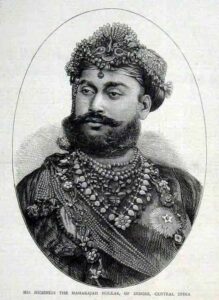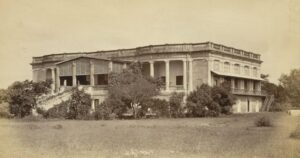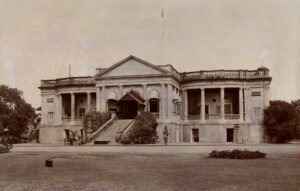
His Highness Maharaja Tukoji Rao Holkar II ruled in Indore when, on the 1st of July 1857, the Mutiny erupted in Indore, Mhow, and subsequently in Mahidpur, Agar, and other places in Central India. At numerous locations, sepoys rebelled against their British officers and commanders, significantly eradicating traces of British military stations and cantonments. In Indore, sepoys and gunners from three companies of Holkar’s army, led by Saadat Khan, an officer in Holkar’s cavalry, attacked the Residency around 8:30 A.M. on July 1, 1857. Bans Gopal, the commandant of Holkar’s army, also joined Saadat Khan. Despite thrice attempting to form pickets at the Residency to counter the mutineers, Colonel Travers was unsuccessful. Treason had effectively disrupted the formation, and despite a gallant charge by Travers and a few loyal sepoys, the British failed to halt the mutineers’ advance on the Residency. Realizing the gravity of the situation, Durand, the then A.G.G. at Indore, placed the ladies on gun wagons and evacuated the Residency with the remaining Europeans, following the road to Sehore. This occurred at half-past 10 o’clock.
On the morning of July 1, the Indore Residency was attacked, and on the same night, the regular troops at Mhow, fourteen miles away from Indore, revolted, killing their Colonel and Adjutant, Platt and Fagan, respectively. The cavalry troopers also killed their commandant, Major Harris, and the mutineers of Mhow and Indore joined forces. In subsequent days, British cantonments near Indore, Mandleshwar, and Bhopawar were also destroyed by the mutineers. Troopers at Mahidpur, an essential military station in the Holkar State, also mutinied, as did the troops at Agar and Dhar. Within three months, the entirety of Central India, including the State of Holkar, was ablaze with the fire of the Mutiny.

The conduct of Holkar during this critical period has ignited controversy. Some scholars argue that he was disloyal to the British. Durand, the A.G.G. at Indore, explicitly suspected Holkar’s loyalty. Conversely, some contend that his loyalty was unimpeachable, deeming doubts on that loyalty insulting to his family and name. Still, others believe he was a neutral observer, sitting on the fence.
While exploring the Government records rooms of the ex-Holkar State, I discovered nearly a thousand letters and reports in the Modi script about the Mutiny period (1857-58). These shed light on the Mutiny within the jurisdiction of H.H. Maharaja Holkar and in other states adjoining the Holkar State. Some letters suggest that Tukoji Rao Holkar was not favorably inclined towards the British. He was pro-mutineer and in communication with Peshwa Nana Sahib, Tatya Tope, and others. The following facts will make this clear.
In the Government records, there is a letter written by Nana Sahib’s agents to Maharaja Holkar, dated 22-10-57. They had been staying in Indore incognito for three months, transmitting daily information to Peshwa Sarkar about all happenings in Holkar’s State and his capital. In this letter, they urged Maharaja Tukoji Rao Holkar that “For the sake of the revered name of Ahilya Bai, it would be better if, after reducing the Mhow cantonment to ashes, you send your troops to Peshwa; otherwise, the Peshwa will be very angry.”
Before the Mutiny outbreak, the Maharaja anticipated trouble in his army. The presence of Nana Sahib’s agents in his capital for months, probably with his knowledge, suggests he expected the Mutiny. Being a Maratha Chief, he desired to secretly further the cause of the Peshwa and avoid active assistance to the British. On May 15, 1857, when Colonel Durand visited Maharaja Holkar at Lal Bag Palace and requested aid in the event of a Mutiny at Mhow, promising every assist ance, Maharaja Holkar explained the incapability of his troops, citing mistrust in them due to fomenting troubles. Even Malleson, in his book “History of Indian Mutiny,” Vol. III, accepts this version, stating that Holkar knew of troubles in his army before the Mutiny and told Durand that he mistrusted his troops.

If the Maharaja knew that the control of his troops was slipping, he could have disbanded the sepoys or taken drastic disciplinary measures to restore confidence. Instead, he issued orders to enlist a large number of young men, especially Wallayatis and Mewatis, for his army, providing them with adequate arms not only for Indore but for all the districts of his State. To equip some of these new soldiers, adequate ammunition was taken from Hinglajgarh, a well-defended fortress of the Holkar State. In a confidential letter dated 2-7-1858, it is stated that “three thousand shells and lead from the fort of Hingalajgarh” were taken out “at the time of the revolt.” To conceal this, it was given out that “the magazine in the fort was blown up,” and the “whole place was leveled to the ground.” Later on, official orders were issued “to put the gun carriage factory in working order,” and Nakhala Singh Golandaz was sent “with the necessary staff to Parda to commence the manufacture of shells.” A recently discovered letter stated that in the Ratnagiri district, Maharaja Holkar had distributed a sum of Rs. 15000 for the preparation of an army and ammunition. Lee Warner points out that Maharaja Tukoji Rao had gone out on a hunting expedition, but in fact, to supervise the casting of cannon. All this was without the knowledge of the British Government, as there is no mention of these facts in British records.
Outwardly, the Maharaja claimed a shortage of arms and ammunition for the protection of the British. On June 5, 1857, he sought assistance from the British Agent at Indore to write to Lord Elphinstone, the Governor of Bombay at that time, to provide military supplies for his troops – 2000 fusils, 300 pairs of pistols, and 4 lakhs of gun caps. The British Agent endorsed the Maharaja’s request, stating, “If these arms can be spared even to half the amount named, a thousand fusils, Holkar would be gratified. I have taken upon myself to order that they receive forty rounds per gun for each battery, with ammunition drawn from Mhow Magazine.”
There is no trace anywhere in the records of how, where, and when such vast ammunition was used by Maharaja Holkar. However, it is recorded that the day before the Mutiny in Indore, the Maharaja’s troops were provided with ammunition recently obtained from the British Government, and it was given out that they looted the Magazine. The same story was repeated at Mahidpur, an important military station of the British, within the jurisdiction of Maharaja Holkar.
All this enables one to infer that:
- Maharaja Tukoji Rao Holkar was expecting some military troubles against the British.
- He had acquired and collected enough arms and ammunition to materially support the anti-British elements.
- He allowed secretly the use of his arms and ammunition by the mutineers.
When the British had succeeded in suppressing the Mutiny to a significant extent, it seems that the Maharaja withdrew his indirect support to the anti-British elements and issued confidential orders for the replacement of certain ammunition taken out from Hingalajgarh. If the Maharaja had used this ammunition against the mutineers, there was no reason why he should have ordered its replacement in 1858. If he had used all this ammunition for the protection of the British officials and their Government, he would have certainly referred to it while claiming territorial rewards for all that he had done for the British during the Mutiny period.
The conspicuous absence of such a reference in the voluminous correspondence of Maharaja Holkar for territorial reward confirms the fact that instead of using this ammunition in the interest of the British Government, it was secretly used against it. It appears that under the pretext of the above-mentioned shortage, Maharaja Holkar had equipped himself well for fighting with those means by which the British had a distinct advantage over the Native Princes and the so-called mutineers.
In addition, instead of prohibiting recruitment from the classes of Mewatis and Wallayatis, who were then planning the revolt all over India against the British and swelling the ranks of the mutineers, Maharaja Holkar himself recruited fresh sepoys from these classes and provided them with military equipment.

When the Maharaja’s troops attacked the Indore Residency, he was within his palace approximately one and a half miles away from the Residency. He neither set out for the Residency to control and withdraw his troops nor opened negotiations with the British Resident and his officials for protection. Within an hour of the outbreak of the Mutiny, Saadat Khan, the ringleader of the mutineers and cavalry officer of his army, had ridden into his presence to report that he had attacked the Residency, wounded, and killed Europeans. Instead of arresting and sentencing him to death for his crimes, the Maharaja allowed him to go away to his house and boast of his deeds among the members of his family.
Malleson states that the Maharaja remained in his palace in Indore until the 3rd of July, 1857, in constant communication with the mutineers and then visited them at the Residency, conversing with Saadat Khan and Bans Gopal—the ringleaders and commandants of the mutineers—and the Subedar of the 23rd Native Infantry, whose hand was red with the blood of his commanding officer.
When the Mutiny had spread all over Central India, Nana Sahib and Tatya Tope entered the southern Madhya Bharat with a vast force to seek material help from the people and the princes. Though Maharaja Holkar did not offer outwardly any substantial material help to the Peshwa and Tatya Tope, he maintained close contact with them, as evidenced by the letters of Hari Trimbak, a person in Holkar’s confidence. These letters are also discovered in Government records of the Holkar State.
Thus, the presence of the agents of the Peshwa in Maharaja Holkar’s capital town, their letters to him, Maharaja Holkar’s expression of his inability in clear terms to safeguard the British Government and its interests and officials, getting arms and ammunition from the British and allowing the mutineers to carry them away before the outbreak of the Mutiny, fresh recruitment of Wallayatis and Mewatis for his army, secretly providing mutineers with ammunition at other places, his passive attitude at the time of the outbreak of the Mutiny at Indore and Mhow, his release of Saadat Khan, the ringleader of the mutineers, his contact and conversation with the mutineers and their leaders on the 3rd day of the Mutiny—all these, when viewed simultaneously, indicate that Maharaja Holkar was not only furthering the cause of the so-called mutineers but also strengthening their hands against the British. He was not free from complicity with the mutineers. Malleson also remarks that “his conduct bore a very suspicious appearance.” Instead of interfering actively on behalf of the British, he was watching the turn of events, encouraging the mutineers, and waiting to throw his lot with the party that would emerge victorious.
Author: B. N. Luniya; Extracted from the “Proceedings of the Indian History Congress”, Vol. 18 (1955), pp. 238-242 (5 Pages)

